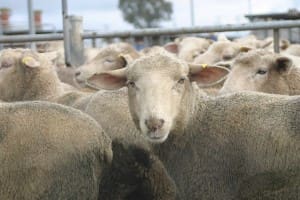
SMALL-SCALE lamb production on mixed cropping-livestock farms continues to dominate industry output, the latest ABARES report on the financial performance of lamb producers shows.
The MLA-commissioned report presented results from the ABARES annual Australian Agricultural and Grazing Industries Survey, focusing on estimates of farm financial performance of lamb producers from 2013-14 to 2015-16.
In 2014-15, about 25,000 broadacre farms sold lambs for slaughter and 71 percent of these sold 200-2000 lambs for slaughter – accounting for 67 percent of total lambs sold to processors.
About 5pc of farms sold 2000-4000 kill lambs and only 1pc of these farms sold more than 4000 lambs, accounting for 10pc of all lambs sold for slaughter.
In real terms, the estimated average farm incomes for 2014-15 and 2015-16 were among the highest recorded since 2001-02.
The Australian lamb industry accounted for about 4pc ($2.32 billion) of the gross value of agricultural production and around 4pc ($1.7 billion) of agricultural export income in 2014–15 (ABARES 2016).
Cropping and lambs still a good mix
The ABARES report said on average in 2014-15, nearly half of lamb producer’s receipts were from selling crops. Lamb sales contributed around one‐fifth of total receipts, wool sales were 14pc and beef cattle sales contributed 9pc.
The report said small‐scale farms received about 10pc of their total cash receipts from the sale of lambs for slaughter on average and very large‐scale farms received 28pc of their receipts from lamb sales. About 17pc of total cash receipts of medium‐scale farms came from sale of lambs.
Farm lamb incomes rising
Farm cash income of lamb producing farms rose on average over the period 2013-14 to 2014-15, the report said. Most of the rise in farm incomes came from higher beef and lamb receipts due to increased prices and sales for both commodities. This was partially offset by reduced crop receipts on many farms that were affected by dry seasonal conditions.
ABARES said the average farm cash income of lamb-producing farms is estimated to have increased further in 2015-16. Receipts from the sale of lambs increased slightly, although the rise in incomes was mainly a result of increased crop, wool and beef cattle sales reflecting higher prices, higher beef cattle turn‐off and greater winter crop production. However, major differences exist in average incomes across states and by scale of production.
Average incomes of lamb producing farms are estimated to have risen from 2014-15 to 2015-16 in New South Wales, Queensland and South Australia. Although receipts from the sale of lambs for slaughter increased, the majority of the increase in farm incomes in these states was from higher cropping receipts.
Average incomes for lamb producers fell in Victoria, Western Australia and Tasmania from 2014-15 to 2015-16. In Victoria and Western Australia, lower crop receipts were partly offset by higher receipts from lambs and beef cattle. In Tasmania, all major receipt components declined as a result of dry seasonal conditions.
The report also estimated rates of return (excluding capital appreciation) in 2015-16 to about 3pc, but the average debt of lamb producers increased in real terms by around 88pc from $323,000 in 2000-01 (in 2015-16 dollars) to an estimated $605,000 in 2015-16. However the proportion if producers’ farm cash receipts were used to make interest payments had fallen to about 8pc over the 10 years to 2015–16.
To read the full report click here.
Sources: ABARES, MLA.

HAVE YOUR SAY